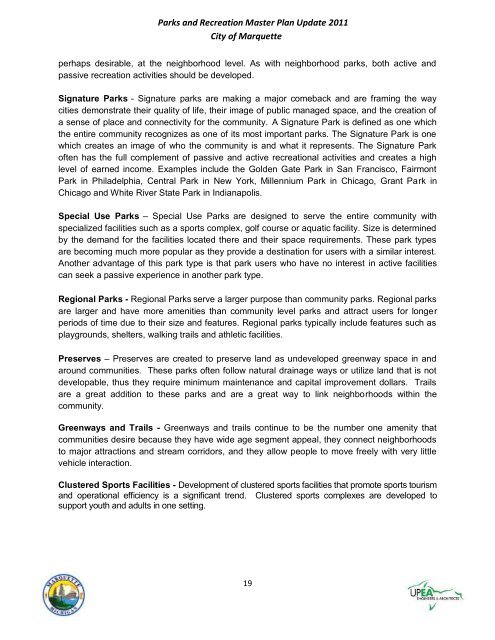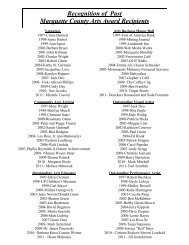Parks & Recreation Five Year Recreation Plan ... - City of Marquette
Parks & Recreation Five Year Recreation Plan ... - City of Marquette
Parks & Recreation Five Year Recreation Plan ... - City of Marquette
Create successful ePaper yourself
Turn your PDF publications into a flip-book with our unique Google optimized e-Paper software.
<strong>Parks</strong> and <strong>Recreation</strong> Master <strong>Plan</strong> Update 2011<br />
<strong>City</strong> <strong>of</strong> <strong>Marquette</strong><br />
perhaps desirable, at the neighborhood level. As with neighborhood parks, both active and<br />
passive recreation activities should be developed.<br />
Signature <strong>Parks</strong> - Signature parks are making a major comeback and are framing the way<br />
cities demonstrate their quality <strong>of</strong> life, their image <strong>of</strong> public managed space, and the creation <strong>of</strong><br />
a sense <strong>of</strong> place and connectivity for the community. A Signature Park is defined as one which<br />
the entire community recognizes as one <strong>of</strong> its most important parks. The Signature Park is one<br />
which creates an image <strong>of</strong> who the community is and what it represents. The Signature Park<br />
<strong>of</strong>ten has the full complement <strong>of</strong> passive and active recreational activities and creates a high<br />
level <strong>of</strong> earned income. Examples include the Golden Gate Park in San Francisco, Fairmont<br />
Park in Philadelphia, Central Park in New York, Millennium Park in Chicago, Grant Park in<br />
Chicago and White River State Park in Indianapolis.<br />
Special Use <strong>Parks</strong> – Special Use <strong>Parks</strong> are designed to serve the entire community with<br />
specialized facilities such as a sports complex, golf course or aquatic facility. Size is determined<br />
by the demand for the facilities located there and their space requirements. These park types<br />
are becoming much more popular as they provide a destination for users with a similar interest.<br />
Another advantage <strong>of</strong> this park type is that park users who have no interest in active facilities<br />
can seek a passive experience in another park type.<br />
Regional <strong>Parks</strong> - Regional <strong>Parks</strong> serve a larger purpose than community parks. Regional parks<br />
are larger and have more amenities than community level parks and attract users for longer<br />
periods <strong>of</strong> time due to their size and features. Regional parks typically include features such as<br />
playgrounds, shelters, walking trails and athletic facilities.<br />
Preserves – Preserves are created to preserve land as undeveloped greenway space in and<br />
around communities. These parks <strong>of</strong>ten follow natural drainage ways or utilize land that is not<br />
developable, thus they require minimum maintenance and capital improvement dollars. Trails<br />
are a great addition to these parks and are a great way to link neighborhoods within the<br />
community.<br />
Greenways and Trails - Greenways and trails continue to be the number one amenity that<br />
communities desire because they have wide age segment appeal, they connect neighborhoods<br />
to major attractions and stream corridors, and they allow people to move freely with very little<br />
vehicle interaction.<br />
Clustered Sports Facilities - Development <strong>of</strong> clustered sports facilities that promote sports tourism<br />
and operational efficiency is a significant trend. Clustered sports complexes are developed to<br />
support youth and adults in one setting.<br />
19



